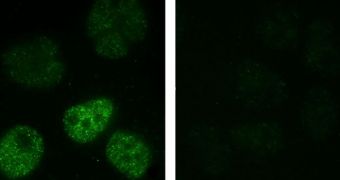According to the latest set of investigations published by scientists at the Brown University, it would appear that human contaminated with nickel nanoparticles are at an increased risk of developing cancer, or having the course of the disease accelerated, if they have already been diagnosed.
Nanoparticles are extremely small, featuring diameters only several billionths of a meter across. As such, they can easily penetrate the human body through nearly all membranes, and even through the skin. Numerous protective measures such as masks are too permissive to stop nanoparticle infections.
Over the past couple of years, so much excitement has gone into nanotechnology that only a few scientists decided to investigate all the effects these particles produce. The issue of whether they are safe or not for the human population has not been entirely set yet.
In the newest research on the topic, an interdisciplinary team based at Brown analyzed the effects of nickel nanoparticles and determined that they tended to activate cellular pathways known to contribute to the development of cancer in the lungs.
Details of the investigation were published in the August advance online issue of the medical journal Toxicological Science. Brown expert Agnes Kane was the senior author of the research paper.
“Nanotechnology has tremendous potential and promise for many applications. But the lesson is that we have to learn to be able to design them more intelligently and, if we recognize the potential hazards, to take adequate precautions,” the investigator explains.
Kane holds an appointment as the chair of the Brown Warren Alpert Medical School (WAMS) Department of Pathology and Laboratory Medicine. Her work is supported through a Superfund Research Program Grant provided by the US National Institutes of Health (NIH).
She explains that nickel does not act directly on lung cells. Rather, ions carried on the surface of the nanoparticles tend to activate a cellular pathway called HIF-1 alpha, which has been proven to encourage tumor growth. It is also involved in supporting cells when hypoxia occurs.
“Nickel exploits this pathway, in that it tricks the cell into thinking there’s hypoxia [lack of oxygen,] but it’s really a nickel ion that activates this pathway. By activating this pathway it may give premalignant tumor cells a head start,” Kane explains.
The researcher explains that, while nickel nanoparticles are indeed a risk factor, they are unlikely to constitute the actual cause of the disease. Lung cancer usually develops as a result of multiple risk factors that come together in an unfortunate combination.
Still, she recommends greater care in the manipulation of such nanoparticles from now, citing her own example of how her team is protected from the dangerous contaminants inside the lab.
“We handle all these materials under biosafety level 2 containment conditions. I don’t want anyone exposed. We’re handling them as though they were an airborne carcinogen,” Kane concludes.

 14 DAY TRIAL //
14 DAY TRIAL //